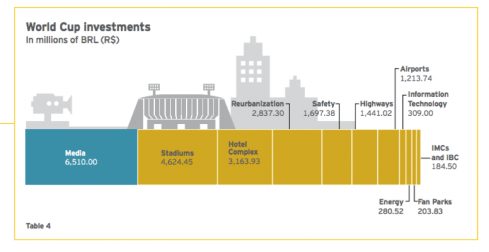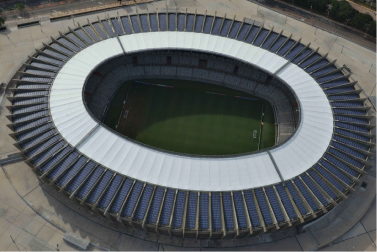Brazil’s Copa Verde: Sustainability at the 2014 World Cup

Who will you meet?
Cities are innovating, companies are pivoting, and start-ups are growing. Like you, every urban practitioner has a remarkable story of insight and challenge from the past year.
Meet these peers and discuss the future of cities in the new Meeting of the Minds Executive Cohort Program. Replace boring virtual summits with facilitated, online, small-group discussions where you can make real connections with extraordinary, like-minded people.
It’s the 2014 World Cup, millions of people from all over the globe are flocking to Brazil to cheer from the stands. While the entire world is tuned in and watching, the question is what impact are the games having on the world?
The biggest single-sporting competition in the world, Brazil has invested R$ 29.6B BRL ($13.3B US dollars), into building and renovating stadiums, hotels, transportation, media and advertising, and technology. Overall, a study by EY estimates the economy to produce an additional R$142B BRL, about 2% of Brazil’s 2010 GDP. Inevitably, the creation of infrastructure on this scale and the mobilization of resources will create waves socially and environmentally. Whether the 2014 World Cup will leave a positive legacy for future games is yet to be seen.

Infographic Credit: Ernst and Young
It was 2011 when FIFA began discussions to develop its Sustainability Strategy for Brazil, the mission being to, “Organize and implement the 2014 FIFA World Cup™ in a sustainable manner by reducing the negative and increasing the positive impact of the event on society and the environment.” The International Standardization Organization (ISO) 26000 standards, served as guidelines to form the key components of FIFA’s 2014 sustainability strategy: Organizational Governance, Environment, Community Involvement and Development, Fair Operating Practices, Consumer Issues, Labor Practices, and Human Rights. As the games continue to play out, we are seeing the implementation of the sustainability strategy taking strides in the environmental sector but missing the mark in some of the social objectives.
Environmental Wins
Environmentally, the FIFA 2014 sustainability strategy focuses on waste, water, energy, transportation, procurement, and climate change. This is the first World Cup in which all 12 arenas are expected to be LEED Certified by the end of 2014. Two out of the 12 stadiums solar powered. In fact, Luis Fernandez, the Brazilian Ministry of Sport, said that in order for the stadiums to receive financing, sustainable construction certification standards had to be met. FIFA and the Local Organizing Committee (LOC) are offsetting all direct emissions, that is the emissions under their direct control. This amounts to 250,000 tons out of 2.7 million tons of CO2 that are estimated to be emitted, according to FIFA.
The waste-management strategy was a collaboration between the Federal Government, Coca-Cola, FIFA, and the LOC. The Brazilian Government’s World Cup site reports that, “The Federal Government opened credit lines for the host cities to invest in the social inclusion of waste pickers…Due to these investments, waste pickers will perform selective garbage collection in and around the arenas and official fan fests of the World Cup. All the material collected will be used by recycling cooperatives.” While the Brazilian government may see this at an attempt at social inclusion, protests in Brazil have highlighted the missed opportunities for social equity in the 2014 World Cup.
Social Implications
The population of Brazil is criticizing the government the amount of investment being poured into one-time use stadiums. Of course, investments in re-urbanization, improved public transportation, and the estimated creation of 3.6M jobs, by Ernst and Young, provides a social return on investment in terms of improved mobility, higher employment rates, and a more skilled workforce. However, the stark inequality of Brazil is exacerbated by the World Cup investments.
A few days before the opening games, at the foot of the $420 Million Sao Paulo stadium, 5,000 squatters set up camp in protest of the country’s poverty levels, reports the UK Daily Mail. Stadium construction caused rents in the area to spiral, resulting in evictions and a lack of affordable housing.
The camp of over 3,000 families was organized by the Homeless Workers Movement and quickly became known as the People’s Cup. The Homeless Workers Movement also organized marches, with as many as 10,000 taking to the streets in Sao Paulo, demanding that the Brazilian government to invest in public services instead of stadiums.
Allen Hershkowitz, Senior Scientist for the NRDC and Visiting Scholar at Presidio Graduate School told the Scientific American in regards to Brazil, “You’ve got to look at the totality of the impacts, not just the material and structural,” he said. “We’ve seen billions of dollars of investment, a very visible endeavor. It’s an area to advance ecologically preferable technologies, but also [to ensure that] issues of equality and social justice are part of sustainability goals.”
It has become clear that while significant efforts were made towards environmental sustainability, the 2014 World Cup missed the mark on incorporating social sustainability as well.
Future Games
While criticism has run high for sustainability initiatives at the 2014 World Cup, it is important to not let perfect be the enemy of the good. FIFA and Brazil has made large strides in sustainable stadium construction, waste management, and offsetting direct carbon emissions. Due to Brazil’s initiatives, green-building certifications will now be required for upcoming games in Russia and Qatar, reports the Environmental Leader. While the 2014 Brazil Games leave much to be desired in terms of social equity, it is important to remember that initiatives towards a more sustainable World Cup only began two games ago, in Germany in 2006.
Looking ahead, Meegan Jones, a sustainability advisor working on the FIFI 2022 Qatar World Cup told ABC, “There’s not a one size fits all in the industry, but the graduating class of 2014 will be working with the 2022 team to set down some of the agreed methodologies and approaches to managing sustainability.”
FIFA is in the nascent phase of developing processes and systems to make the largest single-sporting event in the world sustainable. While it is easy to critique today’s efforts as low-hanging fruits, they are still an immense achievement on an iterative path towards developing a sustainable World Cup.
Discussion
Leave your comment below, or reply to others.
Please note that this comment section is for thoughtful, on-topic discussions. Admin approval is required for all comments. Your comment may be edited if it contains grammatical errors. Low effort, self-promotional, or impolite comments will be deleted.
Read more from MeetingoftheMinds.org
Spotlighting innovations in urban sustainability and connected technology
Middle-Mile Networks: The Middleman of Internet Connectivity
The development of public, open-access middle mile infrastructure can expand internet networks closer to unserved and underserved communities while offering equal opportunity for ISPs to link cost effectively to last mile infrastructure. This strategy would connect more Americans to high-speed internet while also driving down prices by increasing competition among local ISPs.
In addition to potentially helping narrow the digital divide, middle mile infrastructure would also provide backup options for networks if one connection pathway fails, and it would help support regional economic development by connecting businesses.
Wildfire Risk Reduction: Connecting the Dots
One of the most visceral manifestations of the combined problems of urbanization and climate change are the enormous wildfires that engulf areas of the American West. Fire behavior itself is now changing. Over 120 years of well-intentioned fire suppression have created huge reserves of fuel which, when combined with warmer temperatures and drought-dried landscapes, create unstoppable fires that spread with extreme speed, jump fire-breaks, level entire towns, take lives and destroy hundreds of thousands of acres, even in landscapes that are conditioned to employ fire as part of their reproductive cycle.
ARISE-US recently held a very successful symposium, “Wildfire Risk Reduction – Connecting the Dots” for wildfire stakeholders – insurers, US Forest Service, engineers, fire awareness NGOs and others – to discuss the issues and their possible solutions. This article sets out some of the major points to emerge.
Innovating Our Way Out of Crisis
Whether deep freezes in Texas, wildfires in California, hurricanes along the Gulf Coast, or any other calamity, our innovations today will build the reliable, resilient, equitable, and prosperous grid tomorrow. Innovation, in short, combines the dream of what’s possible with the pragmatism of what’s practical. That’s the big-idea, hard-reality approach that helped transform Texas into the world’s energy powerhouse — from oil and gas to zero-emissions wind, sun, and, soon, geothermal.
It’s time to make the production and consumption of energy faster, smarter, cleaner, more resilient, and more efficient. Business leaders, political leaders, the energy sector, and savvy citizens have the power to put investment and practices in place that support a robust energy innovation ecosystem. So, saddle up.








0 Comments